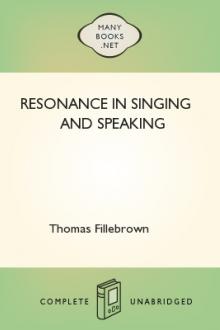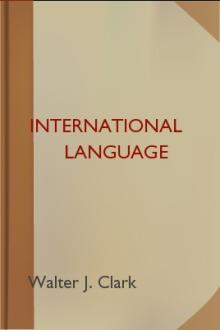Resonance in Singing and Speaking by Thomas Fillebrown (book suggestions .TXT) 📕

- Author: Thomas Fillebrown
- Performer: -
Book online «Resonance in Singing and Speaking by Thomas Fillebrown (book suggestions .TXT) 📕». Author Thomas Fillebrown
Of all the expressions of the human spirit in art form, the sublimated speech we call song is the most direct. Every other art requires some material medium for its transmission, and in music, subtlest of all the arts, instruments are needed, except in singing only.
FREEDOMIn song the singer himself is the instrument of free and direct expression. Freedom of expression, complete utterance, is prevented only by the singer himself. No one hinders him, no one stands in the way but himself. The business of the teacher is to set free that which is latent. His high calling is by wise guidance to help the singer to get out of his own way, to cease standing in front of himself. Technical training is not all in all. Simple recognition of the existence of our powers is needed even more. Freedom comes through the recognition and appropriation of inherent power; recognition comes first, the appropriation then follows simply. The novice does not know his natural power, his birthright, and must be helped to find it, chiefly, however, by helping himself, by cognizing and re-cognizing it.
No student of the most human of all arts—singing—need give up if he has burning within him the song impulse, the hunger to sing. This inner impulse is by its strength an evidence of the power to sing; the very hunger is a promise and a prophecy.
DETERRENTSThe deterrents to beautiful singing are physical in appearance, but these are outer signs of mental or emotional disturbance. Normal poise, which is strength, smilingly expresses itself in curves, in tones of beauty.
Mental discord results in angularity, rigidity, harshness.
Impatience produces feverishness that makes vocal poise impossible; and impatience induces the modern vice of forcing the tone. Growth is a factor for which hurried forcing methods make no allowance.
Excess of emotion with its loss of balance affects the breathing and play of the voice.
Exertion, trying effort, instead of easy, happy activity induces hampering rigidities.
Intensity, over-concentration, or rather false concentration, emotional tension, involves strain, and strain is always wrong.
Over-conscientiousness, with its fussiness about petty detail, and insistence on non-essentials, is a deterrent from which the robust are free. Over-attention to the mechanics of voice production is a kindred deterrent. Both deterrents prevent that prime characteristic of expression—spontaneity.
Anxiety is a great contractor of muscle, a great stiffener. Anxiety always forgets the power within, and falsely says to the song-hunger, "You shall never be satisfied."
Self-repression is a great deterrent that afflicts the more sensitive, particularly those of puritanic inheritance. It is a devitalizer and a direct negative to expression, which is vital, is life.
All of these deterrents are negative and may be overcome by fuller recognition of the inner power that by its very nature must perpetually seek positive expression.
CONCLUSIONIn conclusion, the student can perpetually find encouragement in a number of happy facts.
Man is endowed by nature, except in rare instances, with a perfect vocal apparatus. When abnormal conditions are found they are usually in the adult voice, and are due solely to misuse. In other words defects are not inherent but acquired and can be removed.
By nature the human voice is beautiful, for the tendency of nature is always in the direction of beauty. Whatever is unlovely in singing, as in all else, is unnatural. True method is therefore never artificial in its action, but simple, because the natural is always simple.
Finally, no, not finally, but firstly and secondly and thirdly and perpetually, every student of singing and every teacher of it must constantly bear in mind the happy law:
THE RIGHT WAY IS ALWAYS AN EASY WAY
BOOKS CONSULTED Title Author Published An Essay on the History and Theory of Music, and of theQualities and Capacity of the Human Voice
Isaac Nathan
London, 1823. Elements of Vocal Science Richard Mackenzie Bacon London, 1824. Orthophony; or the Cultivation of the Voice in Elocution William Russell Boston, 1859. Vocal Physiology Charles Alex. Guilmette New York, 1860. Die Lehre von den Tonempfindungen als physiologische
Grundlage für die theorie der Musik
H.L.F. Helmholtz
Brunswick, 1863. The Sensations of Tone as a Physiological Basis for the
Theory of Music
(Translation of above)
H.L.F. Helmholtz
(Translated by A.J. Ellis)
London, 1875. Sound John Tyndall London, 1867. Principles of Elocution and Voice Culture Benj. W. Atwell Providence, 1868. The Voice, Its Artistic Production, Development and
Preservation
George J. Lee
London, 1870. The Cultivation of the Speaking Voice John Pyke Hullah Oxford, 1870. Voice Building Horace R. Streeter Boston, 1871. Principles of Elocution and Voice Culture Benjamin Atwell Boston, 1872. Hints for Pronunciation in Singing Georgiana Weldon London, 1872. The Voice in Singing Emma Seiler Philadelphia, 1872. The Voice as an Instrument Ange A. Pattou New York, 1878. The Vocal Process John Howard New York, 1878. Speech in Song Alexander J. Ellis London, 1878. Voice and Vocalization Wm. P. Robert London, 1879. The Human Voice and Connected Parts Joseph Montgomery Farrar London, 1881. The Mechanism of the Human Voice Emil Behnke London, 1882. Gymnastics of the Voice Oskar Guttmann Albany, 1882. The Art of Voice Production with Special Reference
to the Methods of Correct Breathing
Ange A. Pattou
New York, 1882. The Old Italian School of Singing Leo Kofler Albany, 1882. The Secrets of the Voice in Singing Emilio Belari New York, 1883. Deep Breathing Sophia A. Ciccolina New York, 1883. Artistic Voice in Speech and Song Charles Lunn London, 1884. Voice, Song and Speech Lennox Browne and Emil Behnke London, 1884. Modern Singing Methods, Their Use and Abuse John Franklin Botume Boston, 1885. The Diaphragm and Its Functions J.M.W. Kitchen Albany, 1885. The Voice from a Practical Standpoint Edmund J. Meyer New York, 1886. The Hygiene of the Vocal Organs Morrell Mackenzie, M.D. London, 1886. How to Sing Wm. Henry Daniell New York, 1887. The Art of Breathing as the Basis for Tone Production Leo Kofler New York, 1887. The Voice. How to Train It Edward Barrett Warman Boston, 1890. Scientific Voice. Artistic Singing and Effective Singing Thomas Chater London, 1890. Voice Figures Mrs. Margaret Watts Hughes London, 1891. The Human Voice; Its Cultivation W.H. Griffiths London, 1892. The Philosophy of Singing Clara Kathleen Rogers New York, 1893. The What and How of Vocal Culture F. Rowena Medini New York, 1893. Exercises in Vocal Technique John Franklin Botume Boston, 1894. Text-Book on the Natural Use of the Voice George E. Thorp and William Nicholl London, 1895. Respiration for Advanced Singers John Franklin Botume Boston, 1897. Voice Building and Tone Placing Henry Holbrook Curtis, M.D. New York, 1896. Twenty Lessons on the Development of the Voice George E. Thorp London, 1896. Voxometric Revelation (The Problem Surrounding the
Production of the Human Voice Finally Discovered)
Alfred Augustus North
London, 1896. The Art of Singing Wm. Shakespeare London and Boston, 1898. The Rightly-Produced Voice Edward Davidson Palmer London, 1898. How to Train Children's Voices T. Maskell Hardy London, 1899. How to Sing (Meine Gesangskunst) Lilli Lehmann New York, 1902. Scientific Tone Production Mary Ingles James Boston, 1903. English Diction for Singers and Speakers Louis Arthur Russell Boston, 1905. The Training of Boys' Voices Clarke Ellsworth Johnson Boston, 1906. Voice Production in Singing and Speaking Wesley Mills, M.D. Philadelphia, 1906. The Art of the Singer W.J. Henderson New York, 1906. The Commonplaces of Vocal Art Louis Arthur Russell Boston, 1907. The Singing of the Future David Ffrangcon-Davies London, 1908. The Art of Singing and Vocal Declamation Sir Charles Santley London, 1908. INDEX
Abdominal Breathing, employed by Martel, 4, 26;
lateral, 3.
(See also Chest-abdominal breathing and Lateral abdominal breathing.)
Acoustics, 43;
experiments in, 46-48;
Pascal on, 49.
Actor, enunciation of the, 19;
importance of deep breathing for, 19.
Adam's Apple, the male larynx, 9.
Age to begin study of voice, 77.
Ah-sound, narrow limits of, 18;
how produced, 22;
Lilli Lehmann on, 19;
place of, in practice, 57.
Air Cavities (see Sinuses).
Anxiety, a deterrent to beautiful singing, 85.
Application of Essentials, 79.
Appunn, on pitch of vowel sounds, 20.
Articulation, differing opinions concerning, 3;
relation of, to resonance, 51;
through upper lip, 72.
(See also Pronunciation.)
Articulator, 6.
Artistry, 79.
Ascham, Roger, on voice culture through imitation, 77.
Aw-sound, lip position for, 22;
in exercises, 59, etc.
Beauty of Tone, a criterion of correct vocal action, 56.
Bell, on pitch of vowel sounds, 20.
Booth, Edwin, as a good speaker, 16.
Booth, Junius Brutus, impairment of his voice, 53.
Breath Control, 23-32;
importance of, in both speaking and singing, 23;
muscles of respiration in, 23;
the diaphragm in, 23;
muscles in, 24;
the lungs in, 25;
inspiration, 25;
expiration, 25;
correct method of, 25;
a cure for nervousness, 27;
necessity of exercises, 27;
economy a factor in, 30;
exaggerated, 30;
initial use of, 31;
exercises for, 33-37;
of Farinelli, 37.
Breath Force, initial use of, 31;
reserve, 31;
wasted, 31.
Breath Mastery, meaning of, 32.
Breathing, art of, 3;
an amplification of the daily habit, 5;
defined as singing, 23;
correct, 25, 28;
not differing in sex, 26;
vicious habits of, 26;
controlling deeply, 26;
tests of, 26;
nose versus mouth, 26;
regularity of, 26;
in obtaining power and largeness of tone, 27;
for high tones, 27;
relation of, to nervousness, 27;
rhythmic, 27;
necessity of exercises, 27;
illustrations of, 28, 29;
exercises in, 33-37;
economy in, 30;
tests in, by Professor Mills, 30;
exaggerated control of, 30;
exhaustion, 31;
initial force in, 31;
reserve power in, 31;
mastery of, 32.
(See also Abdominal breathing.)
Broschi, Don Carlo, breath control of, 36.
Browne, Dr. Lennox, on the laryngoscope, 3.
Browne and Behnke, on nasal resonance, 53.
Chest, expansion of and resonance, 49.
Chest-Abdominal Breathing, 25;
illustrated in sleeping child, 25;
tests in, 26;
illustrated, 28, 29.
Chest Tones, former emphasis given to, 2;
wrongly termed, 5.
Clay, Henry, as a good speaker, 16.
Closed Tones, former emphasis given to, 2;
wrongly termed, 5.
Cryer, Dr. W.H., on the frontal sinus, 12.
Culture of the Voice (see Voice culture).
Deep Breathing, importance of, for the actor, 19.
(See also Breathing.)
Deterrents to Beautiful Singing, 84, 85.
Diaphragm, in breathing, 19;
not a muscle of expiration, 23;
described, 23, 24;
in inspiration, 24;
in expiration, 24;
illustrated, 24, 29.
Difference Between Singing and Speaking, 17.
Ear, function of, in tone production, 57;
training of, 57.
Ee-sound, lip position for, 20;
in exercises, 57, 59, etc.
Effort, Tense, a deterrent to beautiful singing, 84.
Emotion, effect on tone quality, 7;
excess of, a deterrent to beautiful singing, 84.
Empiricists, where they have failed, 4.
Epiglottis, 10.
Essentials, application of, 79.
Ethmoid Bone, 8.
Ethmoidal Sinuses, illustrated,





Comments (0)